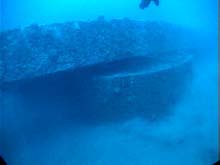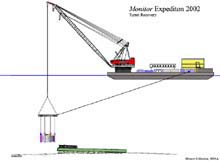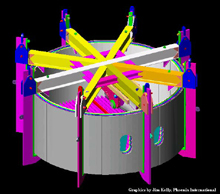
The turret under the hull of the USS Monitor. The damaged hull must be removed before the turret can be recovered. Click image for a larger view.
Excavating and Recovering the Turret
Jeff Johnston
Program Specialist
Monitor National Marine Sanctuary
Removing the Monitor's turret will take weeks of painstaking preparation work because the famous cannon is not immediately accessible to divers. Rather, it sits under the ironclad's damaged hull. Removing the hull will likely be done in pieces, and is expected to take several weeks.
Once the damaged hull has been removed from atop the turret, a second phase of excavation will begin as interior sediment is removed. Navy divers will use a dredge to remove thousands of pounds of silt, sand and sediment, while NOAA archaeologists watch the work via the divers' helmet cameras. Archaeologists will be able to observe and communicate with the divers throughout their dives. This system worked well in past seasons.
Once divers gain access to the turret, the two cannons
and carriages inside the structure will be uncovered. Since the turret is upside down, scientists expect to find both guns and their carriages displaced and lying muzzle-up at an angle.
A claw-like structure known as the Spider will be used to secure the turret. Eight "claws" will grasp the sides and bottom of the turret, allowing it to be lifted off the sea floor. Click image for a larger view.

As shown in this diagram, the turret will be lifted from the sea floor only after it has been securely and safely grasped by the Spider. Both the turret and Spider then will be lifted using strong steel cables lowered from a crane on the derrick barge Wotan. Click image for a larger view.
Securing and Lifting the Turret
At some point during the excavation process when sea and current conditions allow, the novel lifting structure known as the "Spider" will be lowered to the bottom and placed gently over the turret. To ensure that the Spider is situated accurately and without damaging the fragile turret, the operation must take place on a day when sea and current conditions are calm.
The Spider will then be lowered onto the turret. Its eight arms, known as "claws," will be spread out at a 15-degree angle from the vertical. Then, divers will actuate hydraulic valves to lower the claws, one at a time, into position. The pads of the claws then will be placed beneath the turret.
Once the Spider is secured in place, it can be used as a lifting frame for securing objects inside the turret, including the guns and carriages. When excavation and rigging have been completed, and when another ideal weather day presents itself, the Spider will be connected to strong steel cables lowered from the crane on the barge. The turret will be lifted a few feet and set onto a support platform that has been placed nearby on the sea bed. Once the support platform has been secured, the entire assembly will be gently and carefully lifted and placed on the barge.
The barge then will transport the assembly to Newport News, VA, where it will be transferred to a smaller barge for transport to The Mariners' Museum. At the museum, the turret will immediately be placed in a conservation tank, where it will remain for five to 10 years.
What's Inside the Turret?
Scientists expect to find the two iron Dahlgren 11-in cannons inside the turret. They also expect to find two cannon carriages made of a wood and iron composite, and two serving implements. However, it is possible that they may find sea bags containing personal possessions of the sailors who occupied the vessel, and possibly human remains as well. If remains are found, representatives from the U.S. Army Central Identification Laboratory, based in Hawaii will be on hand to provide assistance.
Sign up for the Ocean Explorer E-mail Update List.


































